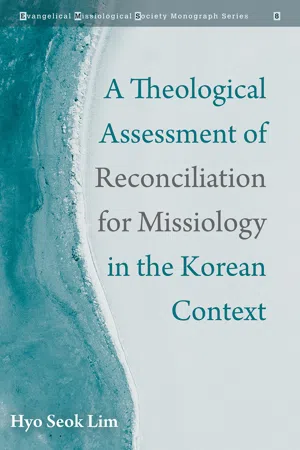![]()
1
Introduction
Research Problem
Today, people live in troubled times of widespread conflicts. Christians are called to be agents of reconciliation in the midst of conflicts. In spite of this, however, the idea of mission as reconciliation, though not new, has not received a full treatment.
In mission studies, the emergence of discourse on mission as reconciliation has occurred since the second half of the twentieth century. The theme of reconciliation has garnered remarkable attention in missiological circles due to the urgent needs surfacing from the continuous conflicts and enmity around the world today. The significance and appropriateness of reconciliation in current mission settings have created an understanding of reconciliation as a paradigm of mission.
In the discourse of mission as reconciliation, several theological loci of discussions exist. One concerns the theological foundation of reconciliation. It denotes that the whole idea of mission as reconciliation is based on reconciliation with God—the vertical dimension of reconciliation. Based on this, discussions on the dimensions of reconciliation appear. There are three dimensions of reconciliation being discussed in academic conversations: vertical, horizontal, and cosmic dimensions. Considering the relentless conflicts found within today’s world, the main focal point of the discussion highlights the horizontal dimension of reconciliation in the Christian understanding of reconciliation.
In mission studies, there is a consensus that vertical and horizontal dimensions of reconciliation should not to be separated. Many would agree with these statements. It is, however, still necessary to examine deeper theological understandings. For instance, what does the statement that they should not to be separated actually mean—in theory and practice? How does the vertical dimension of reconciliation become the source and foundation of the horizontal dimension? What are the similarities and differences between the nature of the two dimensions? To what extent should the horizontal dimension follow the foundational principles of the vertical dimension to be called a Christian understanding of reconciliation? These are the questions of how the vertical and horizontal dimensions are related to each other.
Furthermore, discussions thus far have not sufficiently answered the questions arising from the broken realities of the world in current and historical times. Why and how are these vertical and horizontal dimensions so far from each other in the real world, to the point that they sometimes do not appear related in the church’s understanding and practice? Several studies have approached these questions from different perspectives, yet a clearer picture of the Christian understanding of reconciliation is still required. Today, the realities faced by the church necessitate more robust and wholesome theological and missiological reflections on reconciliation.
These questions from our realities lead our attention to some further theological concerns for the church. How should the church maintain its theology of reconciliation, which includes both dimensions? What kinds of theological, social, or historical understanding within the church have promoted or hindered the separation of these dimensions? These questions, which are strongly related to the church’s theology, also remain not fully answered. Therefore, in this study, a key theological question related to the aforementioned questions is examined—how the relationship between the vertical and horizontal dimensions of reconciliation is to be theologically understood in Christian mission.
A difference seems to exist among scholars in comprehending and systematizing mission as reconciliation involving the vertical and horizontal dimensions, which generally speaking is between conciliar and evangelical scholars. They agree with each other on many major statements of the discourse; however, differences in theological emphases, usage of terms, and missiological motivations and rationales in discussing mission as reconciliation can be identified between the two missiological families.
The issue of the debate centers around the extent of attention given to each of the two dimensions. In other words, this means how the two dimensions of reconciliation should be understood (including the relationship between them) and practiced in the church’s ministry. No one seems to oppose the vertical dimension being foundational for the remaining dimensions of reconciliation, and the dimensions are inseparably related. Some, however, have expressed concern that the current discussions on reconciliation unduly lean toward the horizontal dimension of reconciliation, overlooking the significance of the vertical dimension.
In documents addressing the issue of reconciliation by the World Council of Churches (WCC) and the Lausanne Movement (LM), theological differences can be observed, which are in some extent parallel to the disagreements among these groups. As an example, although the documents of both groups mention the theological importance of the vertical dimension, Athens 2005 by the Commission of World Mission and Evangelism (CWME), and a WCC document, Mission as Ministry of Reconciliation (MMR), tend not to evidently link reconciliation to verbal proclamation, whereas the LM’s documents—the Lausanne Occasional Paper No. 51 (LOP No. 51) and the Cape Town Commitment—explicitly state the needs of evangelism in connection to the ministry of reconciliation.
A few exceptions exist. For example, Jacques Matthey says, “We need to recapture the link between reconciliation and evangelism . . . The search for an ecumenically responsible evangelism was not at the centre of the preparatory process nor of the Athens conference, and this lack of emphasis has been rightly criticized, in particular from European mission circles and by Pentecostals and evangelicals.” Also, reflecting these criticisms probably, in the most recent article on reconciliation, Robert Schreiter acknowledges the importance of evangelism and proclamation as the “co-existed” missional theme with reconciliation. However, this acknowledgment still needs to be examined. Further discussion is given in chapter 5. Besides, theological differences still can be observed between conciliar and evangelical groups, even with this reflection from the conciliar group.
Furthermore, the visible differences between conciliar and evangelical scholars reflect their underlying theological differences in understanding mission. For example, many reports on the Athens 2005 of CWME have observed that pneumatological emphasis was featured throughout the conference.
The emphasis on the Spirit has reshaped the...
